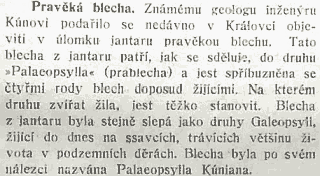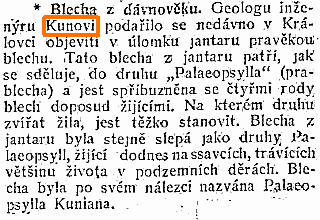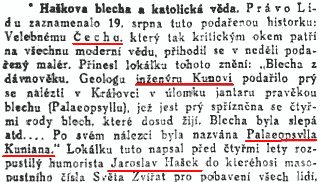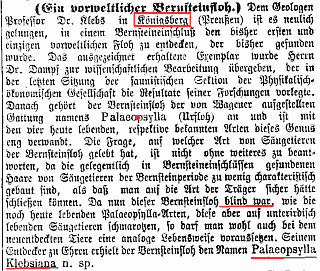Starting from September 2024, this page will contain the webmaster's own articles related to The Good Soldier Švejk and Jaroslav Hašek. The aim is to cover themes that would otherwise span several entries in the "dictionary" categories (people, places, institutions). Some of the external blog entries and individual articles that so far have been filed under Documents will in due course be moved to this page.
On 1 September 1911, the magazine Svět zvířat (The Animal World) printed a brief and unsigned news story titled Pravěka blecha (A prehistoric flea)[f]. It roughly translates as follows: ,1.9.1911
A prehistoric flea. Not long ago the well-known geologist engineer Kún discovered in Königsberg a prehistoric flea in a piece of amber. This flea from the amber is reported to belong to the breed Palaeopsylla (prehistoric flea) and is related to four families of currently living fleas. It is difficult to ascertain on which animal it lived. The flea from the amber was as blind as the four breeds of Galaeopsylla that today live on those mammals that spend most of their life in underground holes. The flea was named Palaeopsylla Kúniana after its discoverer.
Engineer Kún as envisaged during the interwar years. ,17.11.1928
Understandably, such an obscure news item initially went unnoticed. It is therefore mildly surprising that the flea discovery eventually caused a minor stir in a couple of newspapers, but only two years later! In 1913 it was finally revealed that the "discovery" of the flea was a prank by none other than Jaroslav Hašek, a former editor of Svět zvířat, a notorious hoaxer, and author of The Good Soldier Švejk, the novel that saved the flea from total oblivion.
Hašek the prankster
Hašek's small jokes and selected curiosities had appeared in Svět zvířat also during his stint as editor of the journal (1909-1910). These pranks surely contributed to him losing the job, although not in the way that Einjährigfreiwilliger Marek experienced in The Good Soldier Švejk. Once he made the painter Josef Lada into a translator of Hungarian and a poet! He also printed various stories of dubious veracity where it is difficult to distinguish hoaxes from mere curiosities. In 1911 it was the turn of Vilém Kún to lend his name to some obscure item in the animal journal. He was a person who had absolutely nothing to do with geology, amber or fleas. He was however a man of other talents, and importantly: a member of Hašek's famous mock party Strana mírného pokroku v mezích zákona!
Surprising timing
That Hašek allowed himself such small pranks is thus nothing new but the timing of the flea story is all the more surprising. It was published many months after Hašek left Svět zvířat and researchers have with good reason assumed that he didn't contribute to the magazine at all during 1911. A plausible explanation is suggested by Jaroslav Šerák. Ladislav Hájek, at the time editor of Svět zvířat, may have helped his friend Hašek to "plant" the hoax in the animal journal. Otherwise, Hašek could have provided the news in a letter to the editor. In the days before press agencies became common this approach was quite widespread. One example of this method was the famous Grubenhund hoax (by Karl Kraus) that tricked Neue Freie Presse in 1908 and again in 1911.
The flea, resurrected by Lidové noviny...

,12.8.1913

,17.8.1913
In 1913 the flea story curiously reappeared in the Brno newspaper Lidové noviny[b]. The only difference from the item in Svět zvířat from 1911 is that engineer Kún is demoted from a renowned geologist to merely a geologist. Even the typo Galaeopsylla (instead of Palaeopsylla) is faithfully reproduced! One wonders how and why the flea resurfaced two years later, in a newspaper as far away as Brno. Again the clue may be Strana mírného pokroku v mezích zákona because one of the editors was Jiří Mahen (1882-1939), another member of Hašek's "party". Note that we have no proof that Hájek and Mahen colluded with Hašek to plant the stories in Svět zvířat and Lidové noviny respectively but the suspicion lingers...
...picked up by Čech...
Four days after Lidové noviny's revelation the Catholic daily Čech reproduced their article but with a changed headline. They also appear to have carried out some research because they corrected the mentioned typo[c]!
...and exposed by Právo lidu...

,21.8.1913
The note in Čech triggered the story's unravelling because two days later (on 19 August 1913) the hoax was exposed by Právo lidu, sarcastically titled Hašek's Flea and Catholic Science, referring to the article in Čech. It was informed that the news about the flea was published by the humorist Jaroslav Hašek in Svět zvířat (The Animal World) four years ago. Právo lidu drily observed a new development in Catholic science, that Čech who previously drew wisdom from the Holy Scriptures now turned to The Animal World for insight. Franta Sauer claims that it was Hašek himself who wrote the piece that ridiculed Čech. Although Sauer is not regarded the most solid of witnesses he may have a point because at the time when the story of the flea was exposed Hašek contributed frequently to Právo lidu!
...leading to bickering between Čech and Čas
The article in Právo lidu was picked up by several newspapers and one of them was Čas[d]. This seems to have alerted Čech as they immediately provided an irate response[e]. The story of Hašek's flea as quoted in Právo lidu was printed in a number of newspapers and it even reached the USA where several Czech-language periodicals reproduced it. One of them was Minnesotské noviny.
In The Good Soldier Švejk

Osudy dobrého vojáka Švejka.,1921
The story of the flea and the ensuing polemic between Čech and Čas will be familiar to the reader of The Good Soldier Švejk. The incident featured in Einjährigfreiwilliger Marek's long monologue about his time as editor of Svět zvířat. Marek claimed that he had found the flea in some amber, that the flea was blind, and was named after Khún. There the similarities stop as Marek left out some details and replaced them with his own and more imaginative inventions, items that were not mentioned in the original article in Svět zvířat.
In The Good Soldier Švejk the debate between Čech and Čas contributed to Einjährigfreiwilliger Marek's demise as editor of Svět zvířat. In the real world the debate took place three years after Hašek's dismissal as editor and can as such not have contributed to him losing the job. Nor is it true that Čech wrote that "what God does he does well". According to Právo lidu it appeared "at masopust four years ago"[d]. If this had been true it would have been published in February 1909 but it saw day of light in the columns of Svět zvířat much later, on 1 September 1911.
Metamorphosis: From Klebs to Kún

,1.8.1911
The ensuing exchange in the columns of Čech and Čas is well-known because of The Good Soldier Švejk, but the background to the "discovery" of the flea has remained obscure and probably entirely unknown.
Palaeopsylla klebsiana ,2012
Some time in 1910 some dr. Klebs discovered a pre-historic flea in Königsberg and it was preserved in a piece of amber. The item was handed over to dr. Alfons Dampf for further analysis. In December 1910 dr. Dampf published his findings in a scientific journal, down to every detail, and even with drawings of the flea[a].
Already in January 1911 the news of discovery was printed in Westfälisches Tageblatt and Neues Wiener Journal[l] and the description bore a striking resemblance to the report in Svět zvířat. The person in the news was clearly dr. Richard Klebs (1850-1961), a well known German geologist and an expert on amber.
In August 1911 another mention of the discovery appeared in Neues Wiener Journal (with a typo "Krebs"). Almost simultaneously identical texts appeared in some German newspapers (e.g. Rhein- und Ruhrzeitung, Essener Volks-Zeitung), with Klebs correctly written. They all quote Natur, the bi-weekly publication of Deutsche Naturwissenschaftliche Gesellschaft and this is were the text originates from[h].
The story published in Natur is even closer to that of Svět zvířat[f], more so than the news from January. The most striking difference is the name of the man who discovered the ancient flea. He was the known geologist Dr. Klebs and NOT the known geologist engineer Kún! The flea was officially named Palaeopsylla Klebsiana[a]. Hašek's source is most probably Natur as he has an avid reader of natural science literature. The flea is preserved to this day and is exhibited in Göttingen[g]. So in the end the flea is real enough, the prankster Jaroslav Hašek simply translated a short news article from German and took the liberty to change a few letters!
Flea folklore

Franta Sauer claimed that Hašek himself exposed the flea hoax in Právo lidu. This seems probable considering that Hašek wrote frequently for this newspaper in 1913.
Franta Habán ze Žižkova II..,1923
Khún's flea is one of Jaroslav Hašek's best known pranks. Many of the books that were published about the author of The Good Soldier Švejk mention it. Particularly colourful are the claims that were published by Hašek's friends, and some of them have found their way into scholarly biographies and the legend lives on, both in print and on the internet.
From 1913 onwards the prehistoric flea retreated into hibernation and this is where it stayed until Jaroslav Hašek resurrected it in 1921, through the tale of Einjährigfreiwilliger Marek. Then, following Hašek's death, a number of his friends published their reminiscences of the author. Some of them indeed mentioned the flea: Sauer, Emil Artur Longen, and eventually Josef Lada.
Tak napsal dlouhý článek o šťastném objevení prahorní blechy a vylíčil to tak pravděpodobně, že redaktor kteréhosi zahraničního listu, ve spěchu nebo z nedbalosti, článek přeložil a otiskl, aniž uvažoval, je-li to možné. Článek přetiskly i jiné listy s pochybovačnými a posměšnými poznámkami i bez nich a brzy se o prahorní bleše objevily ve světových přírodopisných časopisech sáhodlouhé polemiky a jejich redakce zahrnuly,,Svět zvířat" hrubými výčitkami a radily, aby se šel i s redakčním personálem rovnou utopit. Hašek byl vyhozen bez oné námezdní podmínky: aby dříve za sebe přivedl náhradníka.
Josef Lada, 1954. "Kronika mého života"
Common to all of them is that the flea is presented as Hašek's invention and his friends/biographers don't seem to have realised that it was a simple name-swapping trick. Of particular interest is Sauer's note that it was Hašek himself who blew the hoax in Právo lidu. This seems plausible as the style in the article is typical of Hašek, and moreover: he contributed regularly to this newspaper at the time. It is also striking that Ladislav Hájek (1925) doesn't mention the flea at all, despite the fact that he, as editor of Svět zvířat, was on the "inside" when the story was published. Josef Lada's version of the flea story: invention from A to Z! ,1954
Emil Artur Longen (1928) only mentioned the flea in passing and Václav Menger didn't mention it all all (both were more preoccupied with Hašek's werewolves). The most detailed version was provided by Josef Lada who claimed that the story caused a heated debate amongst foreign scientists! It wouldn't be too far-fetched to assume that the seeds for these claims were planted by Hašek himself...
Flea scholarship

Malá zoologická zahrada,1950.
Serious scholars have also dedicated time to Hašek's flea, but only Břetislav Hůla seems to have read the original entry in Svět zvířat. The proof that he actually did so is in the typo "Galaeopsyll", printed in Malá zoologická zahrada, the first book of only two books dedicated to Hašek's animal stories[i]. Unfortunately, the book has no literature list so future researchers were left in the dark as to when it was actually printed. In 1953 the first ever scholarly biography on Hašek was published by Zdena Ančík. Here the flea is not mentioned and the author limited himself to declare that "Hašek thought up strange animals".
The most thorough study on the theme "Hašek and Svět zvířat" was conducted over many years by Radko Pytlík, Zdena Ančík, and Milan Jankovič and published in 1973. Importantly, it contains an insightful afterword by Pytlík[j] where their findings are explained. It only briefly mentions the flea and the researchers behind the book appear not to have seen the original item. Instead they assumed that it was inspired by another article in Svět zvířat during Hašek's time as editor, about a large breed of flea that vegetated on moles[k]. In the afterword to the book Pytlík inadvertently reveals why they overlooked it: Břetislav Hůla allegedly included material that "could not have been written by Hašek because it was printed at times when he didn't work for the journal".
Radko Pytlík did mention the flea in his early works but because he was one of the few experts/writers who had actually studied Svět zvířat he doesn't make much of it, in say, Toulavé house. It may however come as a surprise that the generally sceptical and thorough scholar Cecil Parrott was careless enough to pass on a summary of Josef Lada's version (without quoting him directly).
His article on 'the newly discovered fossil of an antediluvian flea' was so convincing that it was translated and published abroad.
Cecil Parrott, 1978. "The Bad Bohemian"
Wiki-myths and other fables
Still, Parrott's blunder is relatively minor compared to what others have conjured up. As of 24 September 2024 German Wikipedia occupies the summit of flea folklore by claiming the following:
Die spektakuläre Entdeckung eines Flohs aus der Urzeit beispielsweise sorgte für großes Aufsehen in der Fachwelt - Hašek korrespondierte mit Zoologen aus aller Welt.
This is an example of how the legend was echoed in a serious academic journals.
His hoaxes were sometimes astonishingly successful. So, for example, in 1910, when Hašek was 27 years old, we find him in the function of editor of a Czech periodical, entitled Svět zvířat, a popular publication read by keepers of pets and breeders of domestic animals. It was on the pages of this magazine that the sensational discovery of a prehistoric flea was announced to the world. It was depicted so vividly, with an abundance of convincing arguments and striking details, that newspapers in all countries took it as first rate news. The international interest for the prehistoric flea and its extraordinary discovery was reaching its zenith when, one day, an infuriated scholar, expert in the field, branded it as a gross leg pull. The author of the hoax was none other than Jaroslav Hašek, who had managed to present his story to the public in so skilful a manner and with such gravity, that even critical readers were deceived.
Astrid Baecklund‐Ehler, 1964. “The Missing Years in the Life of Jaroslav Hašek.” Scando-Slavica 10 (1): 94–101
Bæcklund‐Ehler (1908-1976) was indeed right, more so than she was aware of: "Jaroslav Hašek's hoaxes were indeed astonishingly successful, and even critical readers were deceived". This is not to imply that the respected Swedish scholar dreamt it up, she surely drew wisdom from some Czech source, probably Josef Lada. Note that her paper was printed at a time (1964) when critical studies of Hašek's writings in Svět zvířat were still non-existent.
Nor should one be too condescending towards critical readers like Parrott, Bæcklund‐Ehler and numerous others. That scholars and laymen alike have snatched at Hašek's bait is not to imply that they/we are stupid or particularly gullible. It is rather a testimony to how accomplished a hoaxer Jaroslav Hašek actually was!
Literature
- Palaeopsylla klebsiana, Dr. Alfons Dampf,15.12.1910 [a]
- Ein vorweltlicher Bernsteinfloh, ,6.1.1911 [l]
- Ein vorweltlicher Bernsteinfloh, ,6.1.1911
- Ein Floh der Vorwelt, ,1.8.1911 [h]
- k. (Ein Floh der Vorwelt), ,9.8.1911
- kf. Ein Floh der Vorwelt, ,19.8.1911
- Ein Floh der Vorwelt, ,19.8.1911
- Pravěká blecha, ,1.9.1911 [f]
- Ein fossiler Floh, ,11.2.1912
- Pravěká blecha, ,12.8.1913 [b]
- Největší blechy, ,1.3.1913 [k]
- Blecha z dávnověku, ,17.8.1913 [c]
- Haškova blecha a katolická věda, ,21.8.1913 [d]
- Novověká kukačka lapajicá pravěké blechy, ,22.8.1913 [e]
- Pravěká blecha - a klerikální Čech, ,23.8.1913
- Haškova blecha a katolická věda, ,11.9.1913
- Nehody tisku, ,20.10.1913
- Osudy dobrého vojáka Švejka, ,1921
- Franta Habán ze Žižkova II., ,1923
- Jaroslav Hašek, ,1928
- Malá zoologická zahrada, ,1950 [i]
- Kronika mého života, ,1954
- Zábavný a poučný koutek Jaroslava Haška, ,1973 [j]
- Richard Klebs,
- Fossiler Floh, ,2012 [g]
- The Edible Ox, ,7.5.2016
| a | Palaeopsylla klebsiana | Dr. Alfons Dampf | 15.12.1910 |
| b | Pravěká blecha | 12.8.1913 | |
| c | Blecha z dávnověku | 17.8.1913 | |
| d | Haškova blecha a katolická věda | 21.8.1913 | |
| e | Novověká kukačka lapajicá pravěké blechy | 22.8.1913 | |
| f | Pravěká blecha | 1.9.1911 | |
| g | Fossiler Floh | 2012 | |
| h | Ein Floh der Vorwelt | 1.8.1911 | |
| i | Malá zoologická zahrada | 1950 | |
| j | Zábavný a poučný koutek Jaroslava Haška | 1973 | |
| k | Největší blechy | 1.3.1913 | |
| l | Ein vorweltlicher Bernsteinfloh | 6.1.1911 |
| © 2008 - 2024 Jomar Hønsi | Last updated: 20.11.2024 |



